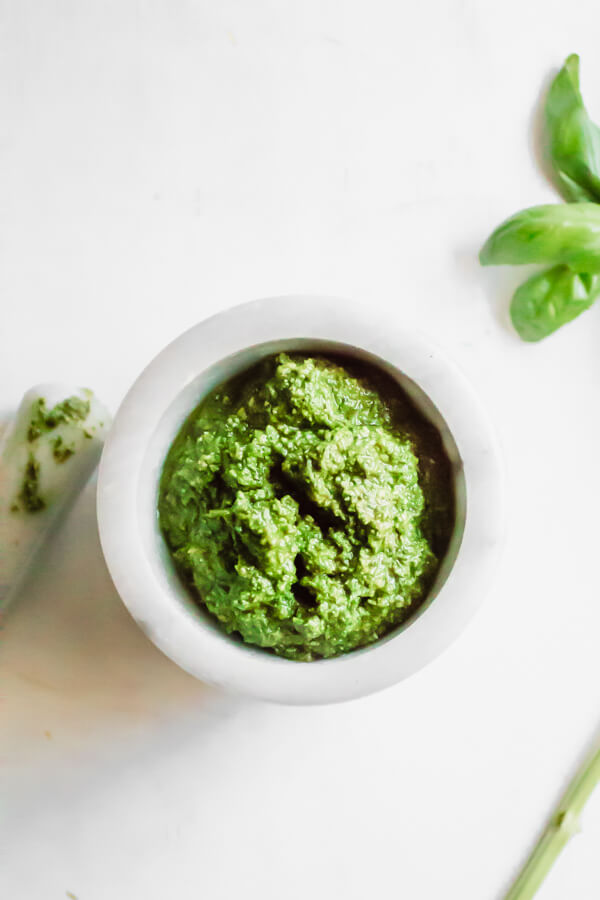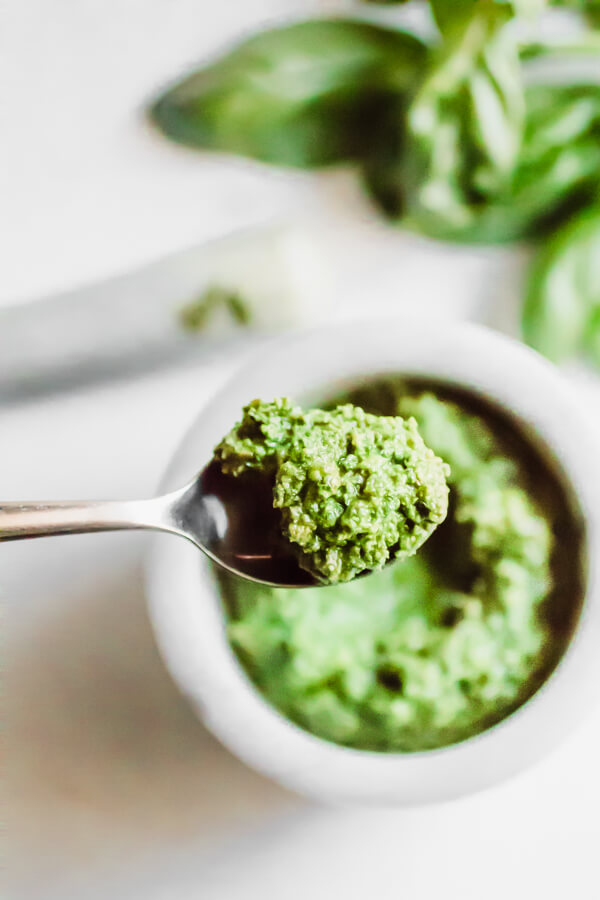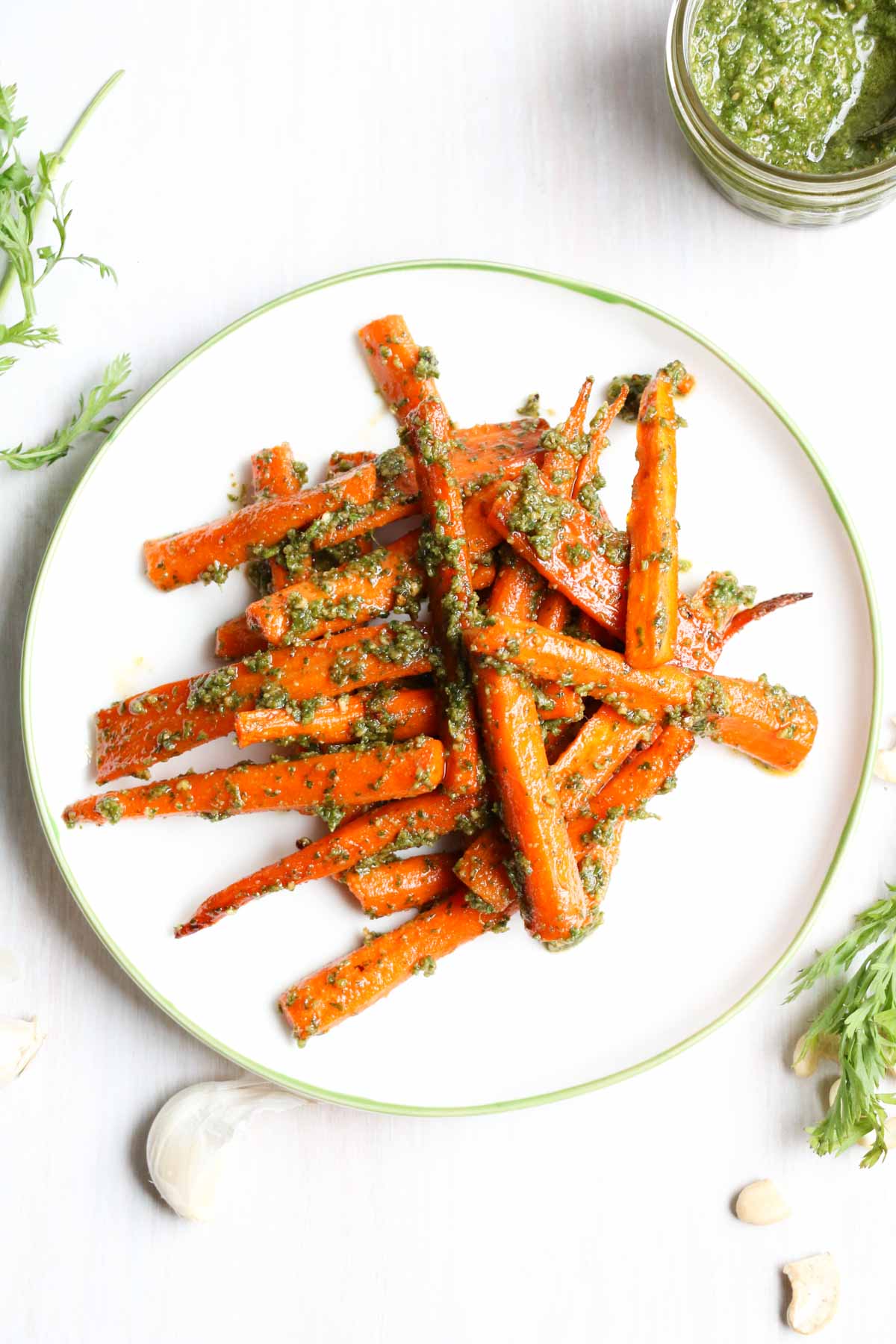A must-have recipe in your repertoire. Peppery basil, sharp pecorino romano cheese, earthy and salty pine nuts, and good olive oil. Perfect for pasta, bruschetta, polenta, or as a sandwich spread.

The Ingredients
- basil, pine nuts, garlic, pecorino romano cheese, good olive oil, salt and pepper.
Can we talk pesto? Like really talk pesto? For just a quick second.
I never knew you could buy it in the store.
Seriously.
I noticed pesto, in a tube, on a grocery shelf a few years ago and was so confused. Do you make your own pesto or buy pre-made? That isn't a judgy question, it's genuine curiosity.
Pesto was one of the first recipes I mastered, and I promise once you make it you will never go back to the tube variety. The very essence of pesto is about fresh, fast, and seasonal. It is the kind of recipe that allows you to throw together 5 simple ingredients and make something special. It is the kind of recipe that allows you to swap, say almonds for pine nuts or kale for half of the basil, and still create something truly special.

Tips to Make Perfect Basil Pesto
- Start with really fresh ingredients. Basil that is plucked from your backyard (I am so jealous if that is your reality), or procured from a local market.
- Make sure your basil isn't wet. If you need to wash the basil (sometimes it comes from the market super sandy, othertimes it is perfectly clean), gently swirl it in a bowl with cold water. Drain and (ideally) spin in a salad spinner to release water. Try not to squeeze or bruise the basil.
- Minimize the garlic. This will be the one and only time you hear me say don't use too much garlic. I LOVE garlic, but I find in pesto it can be overpowering. I tend to start with one small clove and then add more if I want a bit more of a pungent bite.
- Toast your pine nuts, just a few minutes in a dry pan to bring out the very essence of pine-nuttiness.
- Use really good olive oil. I'm sure you see a theme here. When a recipe uses so few ingredients you want to make sure that every single one is top notch.
- Don't be afraid of salt – pesto needs to be well seasoned. I use Pecorino Romano cheese rather than Parmigiano Reggiano because Romano is saltier, and then I still add salt. Taste your pesto and adjust seasoning as necessary.
- <<Unconventional Basil Hack Warning>> Traditionalists will certainly turn their nose up at this tip, but I've done it for 100 years (I'm really old). If your pesto is too thick and you don't want to add more olive oil, vegetable stock works quite well. Add 1-2 tbsp at a time and taste.

How to Make Simple Classic Pesto
- Add pine nuts, garlic, and basil to a food processor (in that order).
- Pulse until finely chopped.
- Drizzle in olive oil while the processor is on, stop to scrape the sides of the bowl several times.
- Add a generous pinch of salt and pepper and romano cheese.
- Process until creamy and well incorporated.
- Taste for seasoning (salt/pepper) and add as needed.
That's it! Seriously could not be easier.

101 Ways to Use Pesto (or at least 5)
Pesto is extremely versatile and works well in a variety of dishes. Here are some of my favorites.
- Toss together with your favorite pasta, this is a classic. Reserve some of your (well salted) pasta cooking water and toss your pasta with pesto and pasta water. The pasta water is starchy and salty and will help to loosen the pesto and turn it into a proper pasta sauce. Finish with a ton of black pepper and a bit more freshly grated cheese.

- Place a generous dollop on top of a fresh vegetable soup. This is called Soupe au Pistou, a classic French vegetable soup (or the French version of minestrone).
- Add to a grain salad. Quinoa with roasted broccoli and pesto is simply dreamy.
- Use as a sandwich spread. Fresh mozzarella, roasted red pepper, juicy tomato, and a smear of pesto on toasted ciabatta bread – OMG – I want that right now!
- Mix it into dips, swirl into greek yogurt, sour cream, or hummus! Add to a gorgeous veggie platter.
- Killer breakfast toast! Sprotued grain bread, scrambled eggs, and pesto. YUM!
- Make the best potato salad you have ever had – potato, green beans, scallions, and pesto.
- Mix into salad dressing, for a seasonal bright pesto salad. Simply thin the pesto with more oil and red wine vinegar to taste.
- Top your veggies with pesto. One of my favorite summertime treats.

- Bake it into bread. Have you tried pull-apart bread yet? Yeah, it's pretty much a genius invention. I've been making one with feta, olives and herbs (I should probably bring that to the blog!) but pesto would be equally phenomenal. Simply score (Slice a loaf of sourdough bread lengthwise in slices, but not fully through the bread, and then slice horizontal, but not fully through the bread, your bread should look like a checkerboard) stuff all the open squares with pesto and mozzarella cheese. Bake for 15 minutes at 375.
- Top polenta with pesto. One of my all time, ALL TIME, favorite ways to use pesto.

Variations on Classic Pesto
- Use a variety of herbs; parsley, dill, cilantro, kale, or even carrot tops!
- Use a variety of nuts or seeds; pumpkin seed, almonds, walnuts, or brazil nuts
- Make it vegan; add a bit of avocado or nutritional yeast rather than cheese

Perfect Every Time Classic Basil Pesto
Ingredients
- 4 cups fresh basil tightly packed
- 1/3 cup pine nuts toasted (see note)
- 1 clove garlic
- 1/3 – 1/2 cup good olive oil extra virgin, first cold pressed
- 1/3 cup pecorino romano cheese grated
- 1/2 tsp sea salt
- 1/4 tsp black pepper
Instructions
- Add basil, pine nuts, and garlic to the bowl of a food processor, process until well chopped. While the processor is running pour olive oil into the feed tube until the pesto comes together. Add cheese, salt, and pepper. Pulse until well combined.
- Transfer to a bowl and use immediately. See notes for storage tips.
Notes
- Nutrition information is for entire recipe.
- Air is the enemy of pesto, it will turn it brown very quickly. Store pesto with plastic wrap or a thin film of olive oil on top.
- To wash basil leaves, fill a large bowl with cold water and swish leaves around, dry using a salad spinner or layers of paper towels.
- To toast pine nuts: place in a dry skillet over medium heat and toast for 3-5 minutes until slightly brown. This step is optional, you can absolutely use “raw” pine nuts.


















